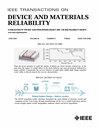NAND闪存抗全电离剂量数据存储新技术
IF 2.5
3区 工程技术
Q2 ENGINEERING, ELECTRICAL & ELECTRONIC
IEEE Transactions on Device and Materials Reliability
Pub Date : 2022-07-11
DOI:10.1109/TDMR.2022.3189673
引用次数: 1
摘要
本文介绍了一种新的非电荷型NAND闪存数据存储技术——水印技术,该技术将只读数据以闪存单元物理性质的形式进行编码。与传统的基于电荷的数据存储方法不同,该技术具有抗总电离剂量(TID)效应的特性。为了评估其对辐照效应的抗性,我们分析了存储在来自不同供应商和技术节点的几种商用单级单元(SLC)闪存芯片中的数据。这些芯片在桑迪亚国家实验室使用Co-60伽马射线源阵列进行高达100克拉(Si)的辐射。在三星公司的闪存芯片上进行的实验评估表明,水印的固有误码率(BER)从TID = 0 krad(Si)时的$\mathbf {\sim}0.8$ %增加到TID = 100 krad(Si)时的$\mathbf {\ mathm {\sim}}1$ %。相反,存储在同一芯片上的电荷数据的误码率从TID = 0 krad(Si)时的0%增加到TID = 100 krad(Si)时的1.5%。结果表明,与传统的基于电荷的数据存储相比,该技术可能会在非常高辐射下显著提高数据完整性。} 100$ krad(Si))环境。相对于基于电荷的数据存储,这些数据完整性方面的增益在辐射易发环境中是有用的,但它们的代价是增加了写入时间和辐射前更高的ber。本文章由计算机程序翻译,如有差异,请以英文原文为准。
New Total-Ionizing-Dose Resistant Data Storing Technique for NAND Flash Memory
This paper describes a new non-charge-based data storing technique in NAND flash memory called watermark that encodes read-only data in the form of physical properties of flash memory cells. Unlike traditional charge-based data storing method in flash memory, the proposed technique is resistant to total ionizing dose (TID) effects. To evaluate its resistance to irradiation effects, we analyze data stored in several commercial single-level-cell (SLC) flash memory chips from different vendors and technology nodes. These chips are irradiated using a Co-60 gamma-ray source array for up to 100 krad(Si) at Sandia National Laboratories. Experimental evaluation performed on a flash chip from Samsung shows that the intrinsic bit error rate (BER) of watermark increases from
$\mathbf {\sim }0.8$
% for TID = 0 krad(Si) to
$\mathbf {\mathrm {\sim }}1$
% for TID = 100 krad(Si). Conversely, the BER of charge-based data stored on the same chip increases from 0% at TID = 0 krad(Si) to 1.5% at TID = 100 krad(Si). The results imply that the proposed technique may potentially offer significant improvements in data integrity relative to traditional charge-based data storage for very high radiation (TID
$\mathbf { > } 100$
krad(Si)) environments. These gains in data integrity relative to the charge-based data storage are useful in radiation-prone environments, but they come at the cost of increased write times and higher BERs before irradiation.
求助全文
通过发布文献求助,成功后即可免费获取论文全文。
去求助
来源期刊

IEEE Transactions on Device and Materials Reliability
工程技术-工程:电子与电气
CiteScore
4.80
自引率
5.00%
发文量
71
审稿时长
6-12 weeks
期刊介绍:
The scope of the publication includes, but is not limited to Reliability of: Devices, Materials, Processes, Interfaces, Integrated Microsystems (including MEMS & Sensors), Transistors, Technology (CMOS, BiCMOS, etc.), Integrated Circuits (IC, SSI, MSI, LSI, ULSI, ELSI, etc.), Thin Film Transistor Applications. The measurement and understanding of the reliability of such entities at each phase, from the concept stage through research and development and into manufacturing scale-up, provides the overall database on the reliability of the devices, materials, processes, package and other necessities for the successful introduction of a product to market. This reliability database is the foundation for a quality product, which meets customer expectation. A product so developed has high reliability. High quality will be achieved because product weaknesses will have been found (root cause analysis) and designed out of the final product. This process of ever increasing reliability and quality will result in a superior product. In the end, reliability and quality are not one thing; but in a sense everything, which can be or has to be done to guarantee that the product successfully performs in the field under customer conditions. Our goal is to capture these advances. An additional objective is to focus cross fertilized communication in the state of the art of reliability of electronic materials and devices and provide fundamental understanding of basic phenomena that affect reliability. In addition, the publication is a forum for interdisciplinary studies on reliability. An overall goal is to provide leading edge/state of the art information, which is critically relevant to the creation of reliable products.
 求助内容:
求助内容: 应助结果提醒方式:
应助结果提醒方式:


